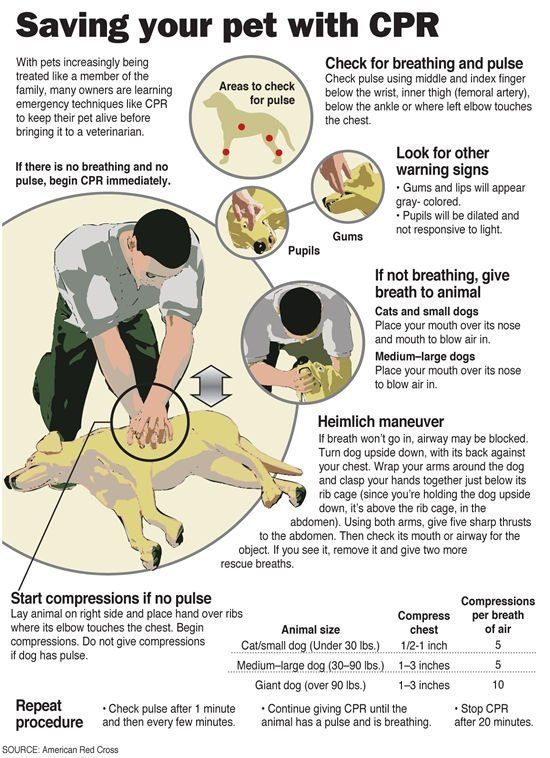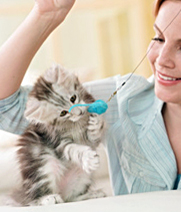Emergency First Aid for Cats
Share

 The idea of something happening to your treasured feline is unfathomable. But accidents do occur and, like most things, there’s no better time to be prepared than now when your cat is playing or snoozing safely at home, and not when it’s in agony and you don’t know what should be done.
The idea of something happening to your treasured feline is unfathomable. But accidents do occur and, like most things, there’s no better time to be prepared than now when your cat is playing or snoozing safely at home, and not when it’s in agony and you don’t know what should be done.
Ann Hohenhaus, DVM, chairman of the department of medicine at The Animal Medical Center in New York City, offers her advice on what to do when your cat gets hurt at home.
[heading style=”fancy” color=”#ff9933″ style_color=”#ff9933″]Bites and Cuts[/heading]If another animal bites your cat, take a clean, absorbent bath towel or kitchen towel and immediately apply pressure to the wound.
“Apply pressure enough to stop the bleeding,” Dr. Hohenhaus says. “It’s likely that your pet won’t like it because there is pain associated with the injury causing the bleeding, but bite wounds don’t usually bleed much.
“Whatever you do, make sure you soothe your cat while you apply pressure, especially if the cat starts to squirm.”
If the bleeding is so bad that you feel you have to apply pressure to stop it, it warrants an examination by a vet, Dr. Hohenhaus says.
“Use common sense,” Dr. Hohenhaus adds. “If it’s a little cut — like the ones you put toilet paper on to stop the bleeding — you don’t need to bring the cat to the vet.”
But you’ll want to be sure to take your cat to the vet if the bleeding doesn’t show signs of stopping.
Finally, always keep your cat (and all of your pets) up to date on their rabies shots because rabies can be transmitted when an infected animal bites a person or another animal.
[heading style=”fancy” color=”#ff9933″ style_color=”#ff9933″]Choking[/heading]
While choking is highly unusual, it can happen. You can try to remove the obstruction carefully with your fingers if you can see and identify it; however, placing your fingers in a cat’s mouth is not recommended unless absolutely necessary due to the possibility of serious injury.
If immediate action is needed, you can also perform a modified Heimlich maneuver on your cat, according to pet expert Warren Eckstein.
First, he advises to straddle your pet from behind.
Next, he says to form a fist below your cat’s last rib.
Gently, yet quickly, push upwards three to five times.
This compresses your cat’s abdomen and it should help to remove the object.
If possible, Eckstein says it helps to have another person assisting, as this second individual can open the cat’s mouth during the maneuver, making it easier for the obstruction to dislodge.
[heading style=”fancy” color=”#ff9933″ style_color=”#ff9933″]Fractures[/heading]You’ll know your cat has a possible fracture if it has a dangling limb, there’s bone sticking out of the skin, the limb is turned the wrong way or the pet isn’t using that particular limb. Your cat might have anything from a minor sprain to a full-blown fracture. Only a medical professional can really determine the severity of the situation, so you’ll want to transport your cat safely to your vet or to an animal ER, if your vet suggests more immediate attention.
To transport your cat safely to the vet, you’ll want to place it in its carrier.
If you can’t get your pet into its carrier because of the injury, place your cat gently on a sturdy cutting board. Lift the cat on the board and place it in an empty laundry basket, cardboard box, picnic basket or any other sturdy container that will keep the cat from jostling too much on the ride to the vet’s office.
And be careful. Your cat may be scared and it might bite you. Biting is one way a cat can communicate distress. Consider wearing gloves when you transfer it into a carrying container.
[heading style=”fancy” color=”#ff9933″ style_color=”#ff9933″]Heatstroke and Burns[/heading]
Cats don’t usually experience heatstroke, but it can happen if you leave your kitty in a heavily heated home or car. If you return to find that your cat is listless, you’ll want to cool it down and get it to the vet.
One idea: Place ice packs in the cat carrier and transport it to the vet as soon as possible.
If your cat has burned its paws walking across a stovetop, for example, the cat will generally heal on its own.
“My cat jumped on an open oven door,” Dr. Hohenhaus recalls. “His foot pad eventually peeled off and he healed fine.” However, a worse burn might require veterinary intervention, so always err on the side of caution and call your vet.
[heading style=”fancy” color=”#ff9933″ style_color=”#ff9933″]Poison[/heading]
Cats are notorious for chewing on lots of things, so a houseplant might tempt your pet, even if the plant is poisonous.
“Lilies (Easter and others) are associated with kidney failure,” Dr. Hohenhaus says. “To be safe, check out new plants before you get them, but if you think your cat may have ingested something poisonous, call the ASPCA Animal Poison Control Center Hotline right away.”
To reach this service, phone 888-426-4435. You’ll be asked to read the ingredients of the product to the poison control expert. They can tell you how hazardous the contents are to your cat’s health and they can recommend what to do. There is a $55 fee for this service.
That said, if your cat is having seizures, is losing consciousness or is having difficulty breathing, you might not have time to call the poison control hotline. Get your cat to the vet or to an emergency pet hospital right away.
Learn more about cat emergencies:
- Blood in Urine
- Checklist for Pet Safety During Storm
- 5 Ways to Secure Your Pet During Travel
- PetPax Emergency Pet Kit
- Top 10 reasons for vet visits











